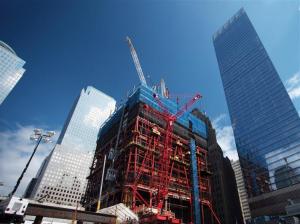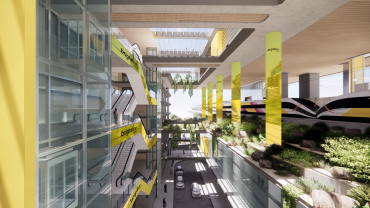For Now, a $2 B. Value on 1 W.T.C., Well Below $3.2 B. Cost
By Eliot Brown August 6, 2010 5:51 pm
reprints A month after first designating the Durst Organization the winning bidder to buy a $100 million stake in One World Trade Center, the Port Authority of New York and New Jersey yesterday announced the basic terms of its agreement with Durst.
A month after first designating the Durst Organization the winning bidder to buy a $100 million stake in One World Trade Center, the Port Authority of New York and New Jersey yesterday announced the basic terms of its agreement with Durst.
In making some of this deal public (though certainly not all), a few interesting tidbits were revealed. Chief among them: The agreement between the Port Authority and Durst values the 2.6 million-square-foot building at about $2 billion—at least based on today’s market. Given that the building is estimated to cost $3.2 billion to build, that means the building is valued today at a mere 63 percent of its total construction cost. (The $2 billion estimated value includes assumptions about rents and leasing—assumptions that the Port Authority would not provide when asked.)
More than anything else, this $2 billion figure speaks to the tremendous cost New Yorkers have elected to pay for symbolism at the World Trade Center site, as the 1,776-foot tower quite clearly is not a wise real estate investment by the numbers. (Taken with the major subsidies afforded two other towers at the site, the parallels with the government-financed original World Trade Center towers, which performed poorly for years, are impossible to ignore.)
Initially, of course, the formerly-named Freedom Tower was not to be such a poor economic bet, but a litany of factors have greatly skewed the picture. To name a few: a politically-led haste to rebuild, layers of security at the site, a rapid redesign pushed by the NYPD, a site plan that puts two to three neighboring giant office towers up at virtually the same time, an overly and interdependent complex site design, an economic crisis, and generally increasing construction costs. All of that for a building that today enjoys few outspoken champions—its only major ebullient cheerleader was former Governor George Pataki—from the public sector that is footing its bill.
The $2 billion figure, of course, could rise, particularly if the building enjoys early success in leasing. It already has a tentative agreement with Condé Nast to take about 1 million square feet in the tower, although the price Conde is paying has not been released.
At least with respect to the Durst deal, the good news is that owner Douglas Durst and his family are not necessarily buying their $100 million stake at the current $2 billion value. The size of the stake that Durst buys will be determined later, when the building is considered to be stabilized, in about nine years, when the joint venture projects more than 92.5 percent occupancy. At that point, the firm’s stake will essentially be whatever proportion of half of the value of the building that $100 million will buy—meaning, if the value of the building is still $2 billion, it would be 10 percent; if the building went up in value, the stake would decrease while the money invested would stay the same.
Still, it’s clear that Mr. Durst and his family saw an opportunity in the low value of the building; he and the other bidders who sought to buy a stake had been trolling the marketplace to buy up distressed real estate assets when the Port Authority reached out to them.
Everything, of course, will depend on leasing and the market, and, to some extent, what becomes of the government leases, which account for about 1 million square feet in the building. They are at about $59 a foot, which is far more than the government would traditionally pay for office space, although the Port Authority has been hoping to increase the rent over time. The initial agreement with the federal government did not specify rent escalations over the length of the lease, as long-term leases typically do.
Then again, with the giant Condé lease pending, one wonders if the owners will turn bullish and start to consider passing on the government leases. After all, with Condé and the state and federal leases, the building would have commitments for roughly four-fifths of the space.


